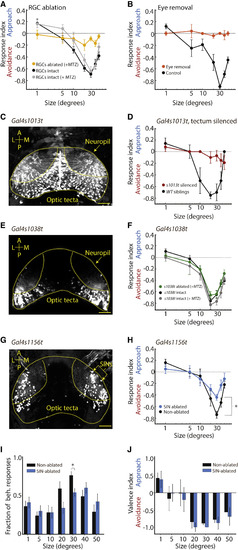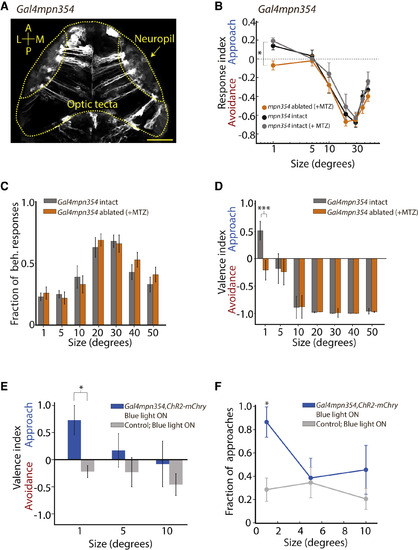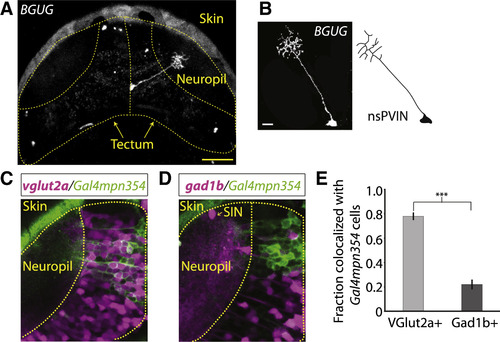- Title
-
Sensorimotor Decision Making in the Zebrafish Tectum
- Authors
- Barker, A.J., Baier, H.
- Source
- Full text @ Curr. Biol.
|
RGCs and Tectal Neurons Contribute to Size Discrimination (A) Size discrimination tuning curves of Atoh7:Gal4, UAS:Nfsb-mChry-ablated fish (n = 14; yellow) and control conditions (Atoh7:Gal4, UAS:Nfsb-mChry with no MTZ treatment, n = 20, black; Atoh7:Gal4, UAS:Dendra with MTZ treatment, n = 10, gray). When RGCs are ablated, values are not significantly different from zero (p > 0.07 for all sizes except 30° [p = 0.039] and 40° [p = 0.012]; one-sample t test; Bonferroni correction). (B) Tuning curves of enucleated and control siblings (enucleated, n = 7, orange; control, n = 10, black). Under enucleated conditions, values are not different from zero (p > 0.30 for all sizes; one-sample t test; Bonferroni correction). (C) Expression pattern of Gal4s1013t shown in a 5-dpf larvae-expressing UAS:EGFP. Gal4s1013t labels a large portion, but not all, of the tectal neurons. (D) Tuning curve in Gal4s1013t-silenced larvae. When compared to WT siblings, Gal4s1013t, UAS:TeTxLC-CFP larvae showed a marked reduction in R.I., with no responses significantly different from zero (experimental, n = 7, red; control, n = 4, black; p > 0.200 for all sizes; one-sample t test; Bonferroni correction). (E) Expression pattern of Gal4s1038t shown in a larva expressing UAS:Kaede. Expression is restricted to the posterior tectum. (F) Tuning curves of Gal4s1038t, UAS:Nfsb-mChry-ablated fish (n = 18; green) and control conditions (Gal4s1038t, UAS:Nfsb-mChry with no MTZ treatment, n = 26, black; Gal4s1038t, UAS:Kaede with MTZ treatment, n = 10, gray). No significant changes in the R.I. are observed in ablated larvae compared to controls (two-way ANOVA with Tukey’s correction). (G) Expression pattern of Gal4s1156t, UAS:Kaede, labeling a subset of the SINs (yellow arrows), as well as additional tectal neurons. (H) Tuning curves for SIN-ablated fish (n = 16; blue) and control larvae (n = 16; black). SIN-restricted ablations were performed in Gal4s1156t, UAS:Kaede using a two-photon laser. R.I. is significantly reduced at 30° (two-way ANOVA with Bonferroni correction; p at 20° = 0.068; p at 30° = 0.040). (I) SIN-ablated larvae show fewer behavioral responses (two-way ANOVA with Bonferroni correction; uncorrected p at 30° = 0.004; same larvae as in H). (J) SIN-ablated larvae have an unchanged V.I. (ablated, n = 25, gray; non-ablated, n = 16, black; two-way ANOVA; Bonferroni correction; same larvae as in H). The scale bars represent 50 µm; A, anterior; L, lateral; M, medial; P, posterior. Hatched yellow lines denote the optic tecta for each image. Neuropil is indicated in the right tectum with a yellow arrow. For all panels, error bars indicate the SEM. p < 0.05. See also Figure S3. |
|
Ablation and Activation of Gal4mpn354 Neurons Alter Behavioral Tuning in Opposite Directions (A) Expression pattern in the 5-dpf optic tectum in a Gal4mpn354, UAS:Dendra fish. (B) R.I. of Gal4mpn354, UAS:Nfsb-mChry larvae (MTZ-treated, n = 31, orange; no MTZ, n = 24, black) and Gal4mpn354, UAS:Dendra (MTZ-treated, n = 12, gray). Following ablation, the R.I. for a 1° dot switches from approach to avoidance (two-way ANOVA; Tukey’s correction; p at 1° = 0.038 and 0.032). (C) The fraction of behavioral responses is not changed in Gal4mpn354-ablated larvae (p = 0.647, 0.621, and 0.655 at 1°, 5°, and 10° sizes, respectively). (D) V.I. plots of fish used in (B). At 1°, V.I. is switched from approach to avoidance following ablation of Gal4mpn354 neurons (Fisher’s exact test; p at 1° = 0.0003; p = 1.00 at 5°; p = 1.00 at 10°). (E and F) ChR2 activation of Gal4mpn354 neurons enhances approach behaviors at small sizes. (E) The V.I. for Gal4mpn354 neurons is shifted to approach when compared to wild-type siblings exposed to the same blue light stimulation (Fisher’s exact test; p = 0.015 at 1°). (F) The fraction of approaches is significantly increased at 1° when Gal4mpn354 neurons are activated (unpaired t test; Bonferroni correction; uncorrected p = 0.014 at 1°). For all panels, error bars indicate the SEM. p < 0.05; p < 0.005; p < 0.0005. See also Figure S5 and Movie S3. |
|
Most Gal4mpn354 Neurons Are Glutamatergic nsPVINs (A) Single cell labeling of a Gal4mpn354 neuron using the BGUG method. (B) Close-up and line drawing of the single Gal4mpn354 neuron shown in (A). (C and D) Examples of co-localization of Gal4mpn354,UAS:GCaMP6s (green) expression and vglut2a:loxP-DsRed-loxP-GFP (magenta) or gad1b:loxP-DsRed-loxP-GFP expression (magenta). (E) The majority of Gal4mpn354-labeled neurons are glutamatergic (VGlut2a; 76%). A minority are GABAergic (Gad1b; 22%). p = 4.8 × 107; unpaired t test. The scale bar in (A) represents 50 µm and in (B) represents 10 µm. Error bars indicate the SEM. p < 0.0005. |



